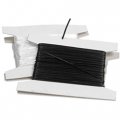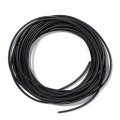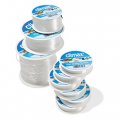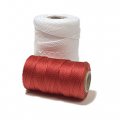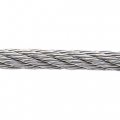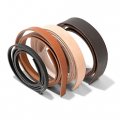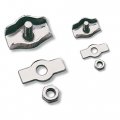Corde e fili di fibre naturali
The chances are that nobody is doing a climb with a hemp rope attached to an Alpine peak anymore - a couple of decades ago, however, there weren´t very many other alternatives available. Today there are any number of synthetic fibre ropes that have much better attributes; ropes that no longer become completely waterlogged and freeze stiff in the cold - nowadays that type of hemp rope is rather used for tug-of-wars! Today there are a wide variety of ropes for all sorts of purposes: for example, special ropes for boating, for constructing exhibitions, for lifting work, for building jungle gyms, etc. Natural fibres like hemp, sisal, manila or coconut are used less and less in the production of modern ropes - synthetic fibres like polyester, polyamide (nylon) or polypropylene are the preferred raw materials. The two basic principles of production, braiding or twisting, have not been tampered with, the only real difference being that the work is now done with very fast machines.
Braided ropes: The production of braided ropes is similar to the dance around the Maypole whereby so-called bobbins alternate in going around in opposite directions, clockwise and counterclockwise, with the threads winding together at a common middle point where they cross one another. That is a very simplified explanation (?) but suffice it to say that braided ropes have been being made for centuries according to this principle of circular motions going in opposite directions. Today there are any number of variations, materials, weaves and nuanced approaches used in making braids – these are then further classified into those with a core and those without.
The core, when a rope has one, is usually made up of a single, twisted or braided fibre strand. Depending on the intended use, it can be somewhat more or somewhat less stretchable and, when compared to the braided outer sheath, can be either thicker or thinner. The function of the core or the sheath is not always the same; while in the case of some ropes, both elements partake of the bearing function, in others the sheath only serves to protect the core against abrasion or impact damage. In some ropes the core strand is pre-stretched in order to keep it from stretching out farther with time after it has been stretched the required amount for a job (e.g. when used as a drum rope to hold a drum skin tight around a shell).
In the case of ropes without cores, the fibres or fibre strands are braided together without a core in the middle. The result, depending on the speed of the production process and the type of weave (plain weave, basket weave, spiral weave, twill weave, etc.) can be either looser (airier) or tighter (more solid). As a rule these types of ropes are more elastic. The more strands that are braided together, the more the finished braided product takes on the characteristics of a tube.
Braiding machines usually work with 48 bobbins which means they are capable of making 48-plaited braids. Most ropes are of the 8-plaited to 16-plaited variety. Beyond 16-plait, a core is usually employed in the construction in order to avoid the the rope becoming like the tube described above.
Twisted/Laid rope: In this kind of construction, fibre such as hemp or the like is first twisted into individual strands which are then themselves twisted together in groups of three or four - with or without a core at the centre. Both of these twisting processes are done either in the same or opposite directions whereby in the former instance more flexible ropes are created and in the latter tighter and more solidly constructed ones.
It is generally true that twisted ropes are more solid and tighter in construction than braided ones but they are therefore less flexible and amenable to being curved. This lack is compensated by the fact that they are also less likely to wear out and are less slippery. In contrast to twisted versions, braided ropes are “rotation neutral”, which means that when lifting a load, neither the rope nor the load hung on it will tend to turn in a particular direction (namely the opposite direction from the one it itself was twisted when constructed – it is, so to speak, twist-free).
Even today ropes are still being made out of natural fibres like hemp, sisal, flax or coconut, whereby hemp provides the tightest and most solid results and remains THE natural fibre for making ropes. Most modern ropes, however, are made with synthetic fibres – primarily polyester, polyamide and polypropylene; there are also newer synthetics that are being developed all the time that have continually better and more specific attributes, for example, high-modulus polyethylene (HMPE), aramid, LCP (liquid crystal polymer) and PBO (Zylon).
Processing: The classic way to join two loose rope ends together (boat rigging ends as well) is called splicing. This consists of taking the strands (of twisted ropes) and interweaving them. When under load, the rope will stretch, becoming thinner in the process: this then increases the friction between the strands that have been joined – such a coupling is much much stronger than one might at first imagine. Braided ropes can also be spliced; the braiding of one end is integrated into the braid of the other. The result is the same for both: under load the weaves tighten and contract and the joint holds.
Different ropes are cut using different methods: synthetic fibre ropes are best cut with a heat cutting machine because during the cutting process the fibres fuse together and do not fray. Rope ends that are already frayed can be repaired by heating them with a cigarette lighter or a soldering iron and using your fingers to reshape them. A strong self-adhesive FABRIC ADHESIVE TAPE can also be used for this purpose. Cutting work on natural fibre ropes is best done with a CUTTER – the heat cutting machine will not work on this type of rope. The rope ends can be secured by means of fabric adhesive tape or, more elegantly, they can be dipped in PLASTI DIP or painted with liquid LATEX - this will produce rubberized ends (or rubberized non-slip pieces or rope).
Then there are the knots: how a rope takes to being knotted depends on the material it is made of and its surface attributes: the stiffer and courser the surface/the braiding, the tighter a knot will be. The finer the braid type, the finer and smoother the rope, with the result that it will not be able to achieve a comparable tightness of knot. Knots in a moist hemp rope are particularly tight – a fact that produced exasperation among past mountain climbers! An overview of various knots can be found at the Wikipedia page: www.wikipedia.de
What is the difference between a rope and “rigging” on a boat and what is the difference between a rope and a cord (or a hawser, or a tether, or a halyard or a string for that matter)? One manufacturer told me, “ For us there are only braided or twisted ropes. Period! Strings are those things produced by Haribo (gummi bear maker) that they put on the back of the licorice snail!” But really, a string could be defined as a thin rope, couldn’t it? Then there is the boating world, which has its own vernacular, chief among them being the use of “lines” when referring to ropes or words like “halyard” which refers to the line used to hoist or lower sails. Mountain climbers, too, have their “dynamic” and “static” ropes (could really be called “elastic” and “inelastic”) and their “reepschnurs” (taken directly from the German!). So you see that the same rope can go by any number of different names depending on the field of endeavor. It is therefore very difficult, if not impossible, to come up with definitive definitions – Ludwig Wittgenstein himself would probably have been exasperated dealing with this topic!
